Reduction Mammaplasty
Macromastia, which refers to overly large breasts, can cause a variety of problems, including neck and back pain, breathing problems, skeletal deformities, and feelings of self-consciousness. The board-certified plastic surgeons at CRS Plastic Surgery will evaluate you, listen to your concerns, and then develop a plan that will effectively reduce excess skin and fat for smaller breasts that are in better proportion to the rest of the body.
How Is It Performed?
Breast reduction is clinically known as a reduction mammoplasty. The breasts are brought up to a higher position on the chest, not unlike a breast lift, and the nipple/areola complex is repositioned. In most cases, your CRS Plastic Surgeon will also reduce the size of the areolae. There are two incision options to access and remove excess glandular tissue, fat, and skin to reduce the overall size of the breasts:
- Traditional incision breast reduction — In this method, an anchor-shaped incision is made that circles the areola, runs down to the breast crease, and follows the breast crease a few inches in each direction. This incision is normally used for women with extremely large breasts. This allows our CRS team to remove the most excess fatty tissue and excise the most sagging skin.
- Vertical incision breast reduction — The incision here is more like a lollipop, circling the areola and running straight down to the breast crease. This is used for women with moderately large breasts and creates a smaller scar than the traditional method.
Would I be a Good Candidate for Breast Reduction?
Large breasts can truly be a pain, both literally and figuratively. They can cause a number of physical and psychological problems for a woman. Here are some specific symptoms that could point toward the need for breast reduction:
- Backaches
- Neck pain
- Headaches and migraines
- Carpal tunnel syndrome
- Spinal problems
- Tingling in the hands
Having overly large breasts can keep a woman from participating in sports and certain types of exercise. Plus, self-consciousness can impact many aspects of her professional and social life. If these issues sound like what you are experiencing, a breast reduction at CRS could be the answer.
What Is The Procedure Like and Where Will My Incisions Be?
Breast reduction surgery is performed with the patient under general anesthesia and takes from two to four hours. There are two typical incision types. The option used by Dr. Low or Dr. Cheung will depend on the extent of sagging skin that needs to be addressed.
- Traditional incision breast reduction — In this method, an anchor-shaped incision is made that circles the areola, runs down to the breast crease, and follows the breast crease a few inches in each direction. This incision is normally used for women with extremely large breasts. This allows our CRS team to remove the most excess fatty tissue and excise the most sagging skin.
- Vertical incision breast reduction — The incision here is more like a lollipop, circling the areola and running straight down to the breast crease. This is used for women with moderately large breasts and creates a smaller scar than the traditional method.
In both cases, fat, excess glandular tissue, and skin are removed. The nipples and areolae are usually relocated to a higher position, as well. The areolae will likely be reduced in size.
Breast Reduction Before & After
Before
After
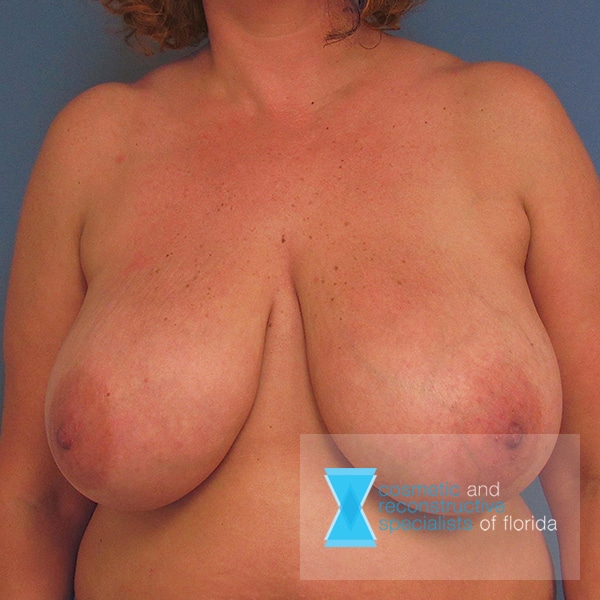
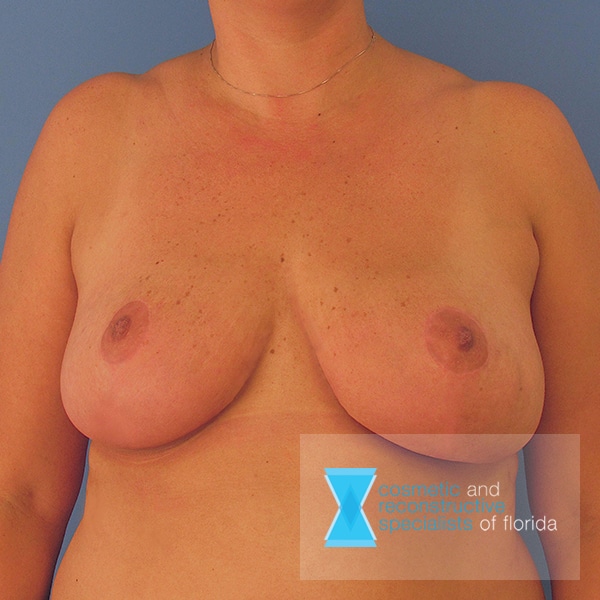
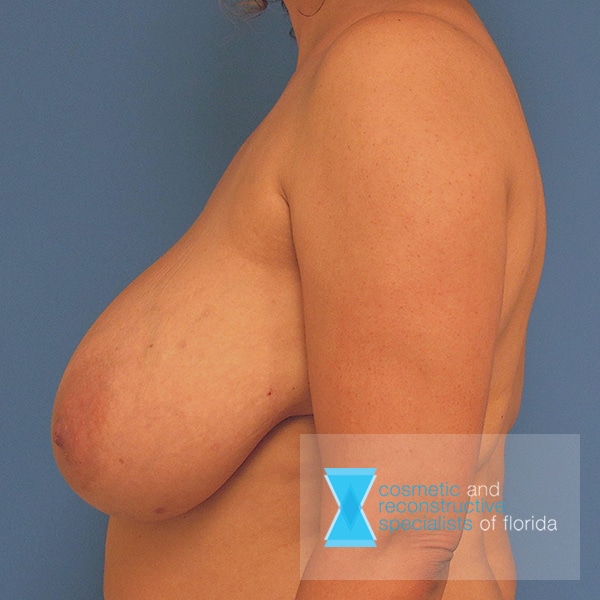
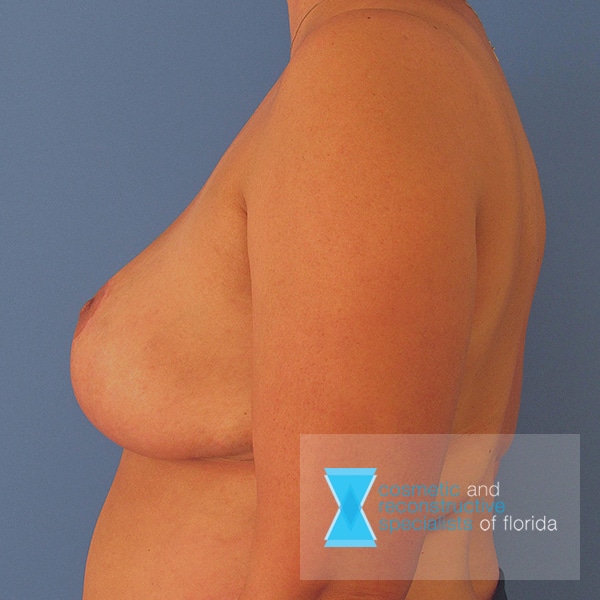
Before
After
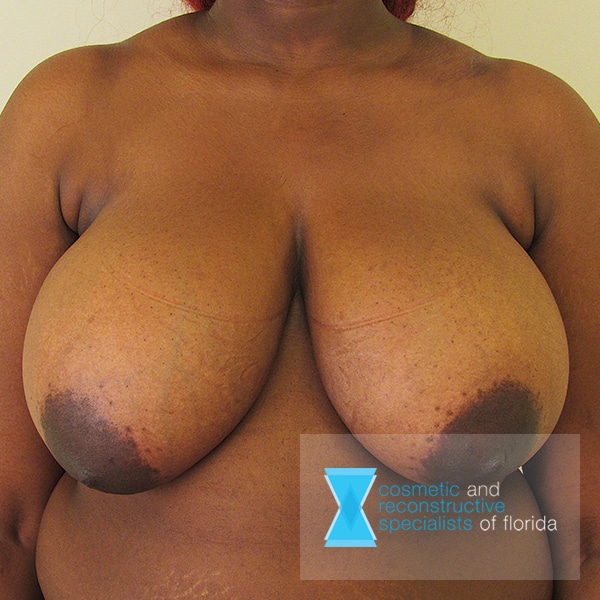
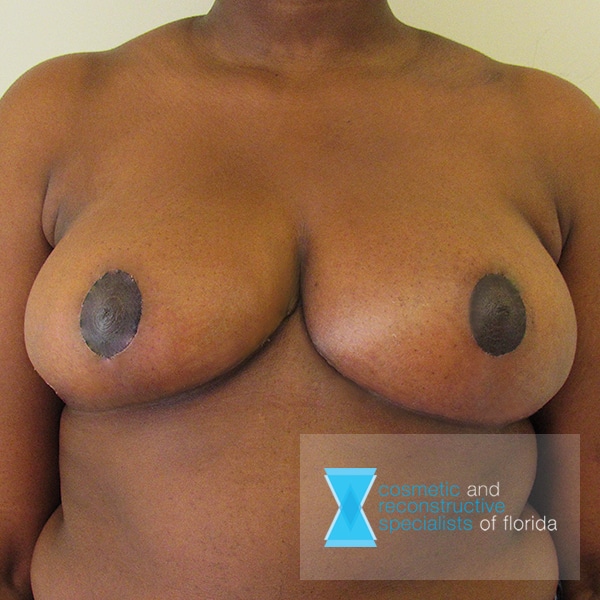
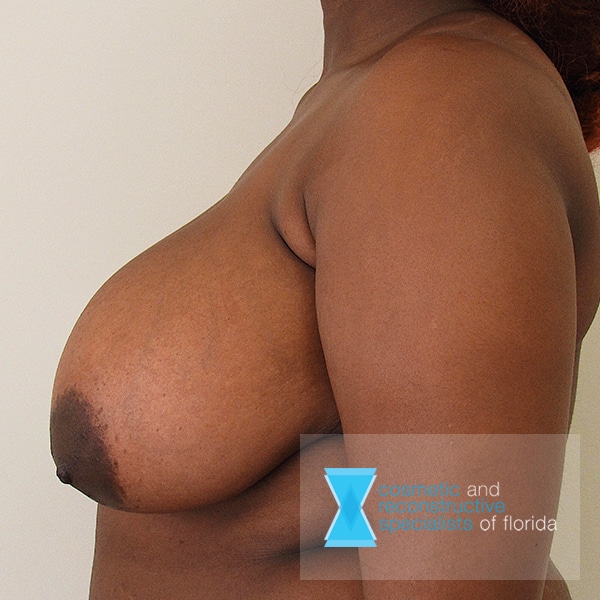
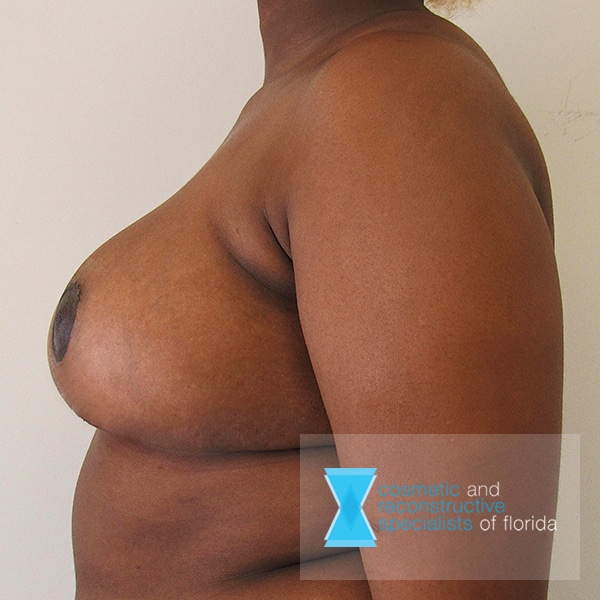
What is Recovery Like After Breast Reduction Surgery?
These are fairly involved surgeries, and there is a good deal of tissue repositioning. Plus, the incisions are lengthy. This creates bruising, swelling, and soreness. When you return home, your breasts will be fully bandaged and in a surgical bra. You’ll have to take it easy for the first one to two weeks and avoid strenuous activity for probably six weeks. You’ll need to take at least one, and more likely two, weeks off of work.
Probably the most important part of your recovery is to be diligent about providing support for your reduced breasts. You’ll transition from a surgical bra to a support bra and then finally to a strong sports bra. These must be worn 24 hours a day for at least one month. This can seem tedious, but it’s necessary to avoid placing any stress on your incisions. By being diligent with this your scars will stay as thin as possible and will heal better. It’s usually necessary to move the nipples with this procedure. Our CRS team makes every effort to maintain nipple sensation and breastfeeding function after breast reduction, but this is not always possible.
Will I be Able to Breastfeed After Breast Reduction Surgery?
During this surgery, glandular tissue is removed, milk ducts and nerves likely will be cut, and the nipples are relocated to a new, higher location on the chest. All of this impacts the ability to breastfeed. We do our best to minimize impact, but the changes made to the breasts are extensive.
There’s no way to know for sure if your breastfeeding capability has been impacted until you become pregnant and find out. But there is a good chance that breastfeeding will be diminished if not impossible.
Will I Lose Feeling in My Nipple After Breast Reduction Surgery?
While Dr. Low and Dr. Cheung make every effort to minimize any disruption to your nipple sensation, there is a good chance there will be some diminishment in sensation. That’s because this procedure removes excess breast tissue and skin, and it typically requires the nipples to be moved. It can be very difficult to preserve all of the nerve connections. Some of this sensation can return as the nerves adjust.
Still, most patients feel the gains made through breast reduction are well worth any loss of sensation in their nipples.
What Are The Potential Risks with Breast Reduction Surgery?
The main risk specific to this surgery is loss of nipple sensation or overall changes in breast sensation. This is because the nerves can be impacted by the relatively extensive changes in the breasts. Also, the ability to breastfeed can be impacted by this surgery. We work to avoid these issues, but they are possible.
Really, when considering the risks involved with breast reduction surgery, there is more risk to your health in not addressing your heavy, sagging breasts. Problems such as back and neck pain, nerve compression, posture issues, and the like will only worsen as you get older. Improving these issues by having this surgery will correct those. Plus, we’ve found this surgery gives patients a new impetus to engage in more exercise and outdoor activities because they don’t have to cart around their heavy breasts and they no longer worry about undue attention. That’s good for your overall health moving forward.
Is There Anything I Can Do To Make My Scars Less Visible?
The best advice for managing or attempting to minimize the appearance of your scars is to leave the silicone wound dressings in place until your CRS surgeon removes them at your follow-up. Also, wearing your surgical bra and then your support bra at all times during the first 4-6 weeks is critical. This eliminates any pressure on the incisions, which keeps the scars as thin as possible. It also helps eliminate some of the redness.
Keep your scars out of the sun. Healing skin is extra sensitive, plus sun exposure makes scars darken. A product called bioCorneum+ SPF 30 is a good topical silicone treatment that doubles as a sunscreen. It creates an invisible protective layer over the scar. This keeps it clean, supported, and shielded from UV rays.
Topical scar-minimizing treatments keep the area moisturized and help to minimize the appearance of the scars. SkinMedica makes one such product called Scar Recovery Gel with Centerline.
Lightly massaging your scars can help them heal more smoothly. But you cannot do this too early and put stress on your incisions. Ask Dr. Low or Dr. Cheung when massage could be appropriate, along with the proper technique.
Is Breast Reduction Covered By Insurance?
These procedures can be covered by insurance, but they need to be tied to a health issue or issues that your oversized breasts are causing. This could be tingling in your hands, nerve compression in your neck, even chronic rash formation under your sagging breasts. Usually, a physician will need to be behind those diagnoses to gain insurance approval. We’ll discuss this with you during your consultation.
Schedule Your Consultation Today
If you're interested in learning more about breast reductions please contact us for a consultation at 954-466-0325 or fill out our contact us form. We will discuss your needs and concerns, and determine your best course of action.


